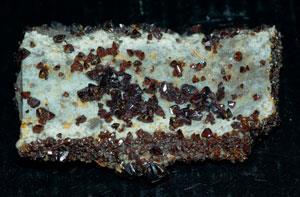Mineral-based photochemistry could have led to the beginning of life
Chinese scientists have taken a step towards further understanding the reactions that led to the origin of life by showing that a crucial metabolic process can be photocatalysed on the surface of a common mineral.
The citric acid or tricarboxylic acid cycle is central to almost all life and is used to generate energy from the conversion of acetate from fats, proteins and carbohydrates to carbon dioxide and water. Some bacteria run this cycle in reverse in a reductive tricarboxylic acid cycle (rTCA), making carbon compounds from carbon dioxide and water, and this has been suggested to be the central part of primordial metabolism.
Wei Wang from Harbin Institute of Technology and colleagues claim that early reactions to form biological molecules and metabolic pathways could have occurred on the surface of sulfide minerals in under-sea hydrothermal vents. This could explain why enzymes containing transition metal-sulfide clusters play a vital role in the metabolism of most organisms.
Wang’s team used the mineral sphalerite (ZnS) to photocatalyse the reversible reductive amination of alpha-keto acids, which could balance the entry and exit of metabolites from the rTCA (a process known as homeostasis). ’Previous studies have mainly focused on the fixation of gas molecules, the reduction of metabolic intermediates and the extension of molecular chains. Up to now, little attention has been paid to archaic redox homeostasis,’ says Wang.

Their experiments showed that under UV irradiation, sphalerite could catalyse both the reductive amination of alpha-ketoglutarate (an intermediate in the rTCA) to the amino acid glutamate and the reverse reaction. The system could also catalyse three other reversible amination processes needed for homeostasis - the conversions of amino acids alanine, glycine and aspartate from, and to, rTCA metabolites. These results not only suggest a new pathway for the formation of amino acids, but they also suggest an early way of regulating primeval metabolism.
Marcelo Guzman, an expert in prebiotic metabolism from the University of Kentucky, US praises the work. ’The work addresses a fundamental problem for the emergence of biochemistry from geochemistry on Earth,’ he says, but he does suggest that further investigations are needed. ’Given the relatively low yields reported (that are, however, much higher than those obtained by other processes), what is the minimum yield for an individual reaction that would allow the metabolic pathways to keep operating?’ he asks.
Wang’s team plans to continue investigating early homeostasis by developing transition metal doped ZnS that can photocatalyse these fundamental reactions using only visible light, which made up the majority of the primordial solar spectrum.
Helen Potter
References
W Wang et alChem. Commun., 2012, DOI: 10.1039/<man>c2cc15665b</man>






No comments yet